Archive for February, 2011
Opening of Wendy Sharpe exhibition at the S.H. Ervin Gallery
Feb 28th
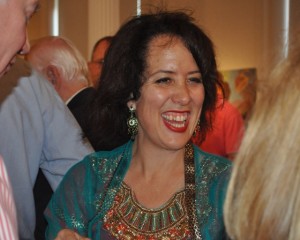 Wendy Sharpe is one of the most exciting artists in Australia today, and her career is in full bloom. A survey exhibition of her work has just opened at the S.H. Ervin Gallery on Observatory Hill in Sydney, and ArtWriter was there to record the event for these pages.
Wendy Sharpe is one of the most exciting artists in Australia today, and her career is in full bloom. A survey exhibition of her work has just opened at the S.H. Ervin Gallery on Observatory Hill in Sydney, and ArtWriter was there to record the event for these pages.
The exhibition was full of the boisterous energy and love of life that fills Sharpe’s works, from her paintings to her drawings and sketch books, from her studies of the nude to her travel-scapes and her quirky portraits of herself and others.
The exhibition is called Wendy Sharpe: The Imagined Life. It is on display at the S.H. Ervin Gallery until April 10. A new DVD by Catherine Hunter and Bruce Inglis featuring Wendy, her partner Bernard Ollis, and ArtWriter, has been released to celebrate this landmark show. A new book has also been released.
I hope you enjoy these images. I enjoyed taking them.
Elizabeth Fortescue, February 28, 2011
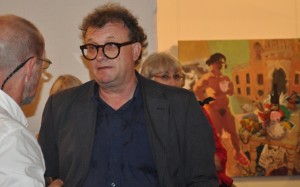
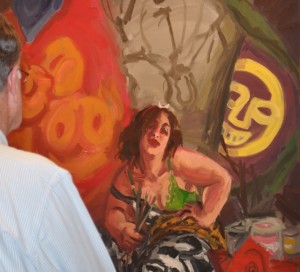
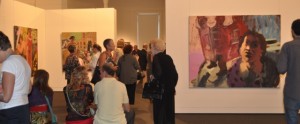
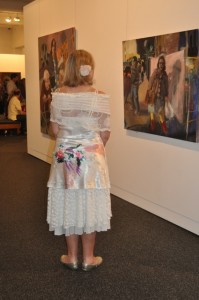
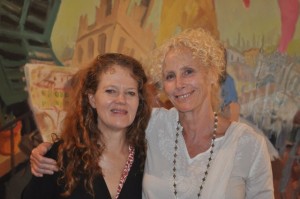
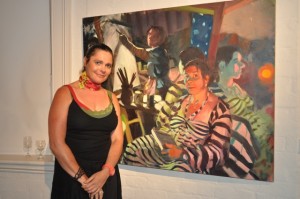
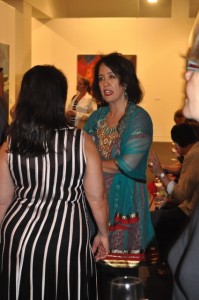
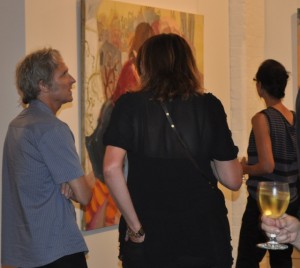
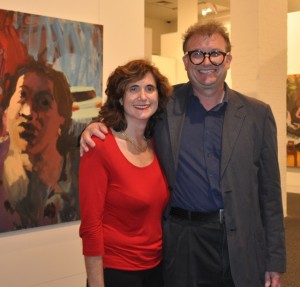
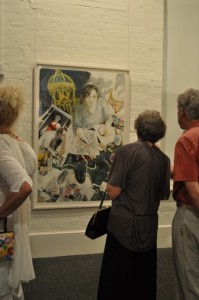
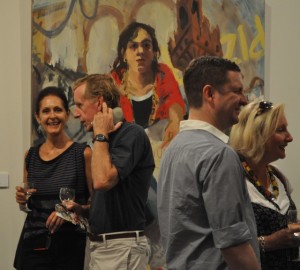
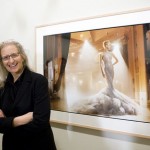
Annie Leibovitz meets the Sydney news media at the MCA
Feb 11th

Annie Leibovitz at the MCA, Sydney, February 2011. Photograph of Leibovitz courtesy of Ben Symons and the MCA.
Invited media toured the show with Leibovitz, who spoke about selected works and answered questions from journalists. She walked into the exhibition alongside MCA director Elizabeth Ann Macgregor, looking elegant in black. Her demeanour was relaxed and chatty.
I covered this story for the Daily Telegraph, Sydney. But the opportunity to hear Leibovitz speak was so rare that I decided to upload my edited transcript of her comments on my website.
I would like to thank Ben Symons and the MCA for the photographs I have used on this page. Symons took them during the media call.
Elizabeth Fortescue, February 11, 2011
Annie Leibovitz: This show came out of a book which was an edit of work from 1990-2005. Susan Sontag had just died. As I sat down to start that edit I realised those were the years I was with Susan. I thought that what I would do is maybe look at this work as if Susan was looking over my shoulder. On some level, it was with Susan’s help. Susan had just died, my father had just died, my children were being born. So as I started to go through my work looking for a picture of Susan, I started to see this whole story here. I think at the time I was thinking, this is everyman’s story. This is not me. I saw birth, I saw death, I saw life. I thought, this is a bigger story than my everyday assignment work. I thought that I would hold these pictures out and make a story, and I pulled it together with the assignment work and I think it really worked together. I am the same person, I realised [both bodies of work] came from the same place. At the end of the show there’s two working walls. One wall has assignment work and one has the personal work, and those walls were reconstructed the way they actually were [while she worked on editing the show]. So, here we go. I should also say, in retrospect as time goes farther and farther away from creating this work, its focus is singular to that moment. I can’t go back and alter it. Last night and this morning I was thinking, I can never do this again. Put my family … I had second thoughts about putting even Susan in that position. I don’t know if you’ve read Joan Didion’s book, The Year of Magical Thinking, but it came out of this moment: oh this is so important, I’ve discovered love and birth and death and it’s a great story and I have to get it out. Now I’m a different person looking at this work.
Leibovitz stopped in front of her photograph of her father and brother, titled “My brother Philip and my father, Silver Spring, Maryland, 1988”.
This is just at the moment when my brother had his first baby. They were just feeling very… I think they were just identifying with each other. Literally Philip’s wife Niki and the baby were just off to the left as is my mum, and we were around the family pool, and when I started taking pictures I started at the San Francisco Art Institue. My mentors were really Robert Frank and Cartier-Bresson. And it was personalised reportage. That was my foundation, that’s where I started. This is the work that I brought to my assignment work. The more formal work came out of covers for Rolling Stone magazine when I started to pose people. But this is really the foundation to my work. You go through the show, you’ll see, I never stopped taking these picturtes. These pictures are always there.
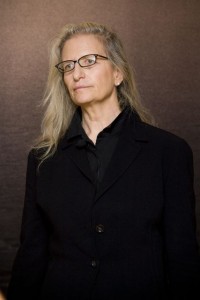
Annie Leibovitz at the MCA, photograph courtesy of Ben Symons and the MCA
Leibovitz stopped in front of her nude photograph of Demi Moore pregnant. She spoke about how, although she got to know Bruce Willis and Demi Moore very well, she doesn’t “sit there and have Kellogg’s Corn Flakes with Mick Jagger. I understand that I’m there to take pictures, and I go on with my life. Hence the reason to build a life. When I was young I lived from assignment to assignment and I never went home. But at a certain point, you start to separate [work from life].
In any case, when Demi was pregnant with her first child I said, gee I’d like to photograph you pregnant. I’ve never really photographed a pregnant woman. I did these private pictures for them. They weren’t for publication. Very simple, portraits of Bruce and Demi together. So when Demi was pregnant with her second child and Vanity Fair asked me to do the cover of Demi, everyone at Vanity Fair was busy wondering, oh how are we going to take her picture, she’s pregnant, how can we do this without showing she’s pregnant? So I got out to California, Demi and I started taking pictures, and then part way through I said listen let’s takes some pictures for you, and I started taking some nudes of her. And I said you know what, this could be the cover. She got into it. You have to understand, working with Demi Moore is like being dragged behind a car. She would just literally take over whatever we did. She had more energy and ideas than anyone. It was a great collaboration. So we did this and I got back to New York and I showed this to Tina Brown and Tina was concerned about running it. She said she didn’t want to run it unless Demi Moore felt really comfortable about it, and there was a lot of conversations back and forth. It became more controversial than we expected. We had no idea it would mean so much. A woman when she is pregnant is expected at that time to not exactly parade it around. It’s true that not everybody looks like that [Demi Moore] when they’re pregnant. It was quite beautiful because doctors actually took the cover and framed it and put it in their offices. And of course now we have Britney Spears posing like this and everyone else. It became a celebration about being pregnant rather than it was a time that you should hide away. So it was a nice moment.
Leibovitz spoke about her photograph of the artist Cindy Sherman, where Sherman is in a line-up with a group of other women all dressed the same as her.
She is a great artist who photographs herself. I was extremely intimidated. I admire her so much. I didn’t really know what I was going to do. I went to see her at her loft in New York and she came to the door dressed like this. And I sat down with her and said what would you like to do? And she said, I like types. It just hit me. I said well why don’t we do 10 Cindy Shermans and you try to figure her out. She loved the idea. I found a casting agency who helped me find young actors and some were willing to cut their hair. I had about 15 other women here. Years later I was doing Claire Danes for the cover of Vanity Fair and I said very nice to meet you and she said oh no no we’ve met before, and I said where, how? And she said well you cut me off the end of the Cindy Sherman photograph. It’s true, I looked back and I did find her somewhere over here.
She spoke about her portrait of Leigh Bowery.
Lucian Freud did that whole series on Leigh Bowery. He [Bowery] came to my studio and he brought his partner. They do the birthing act and all these different things. I was enamoured with Lucian Freud’s paintings and I just wanted to do a nude. But [Bowery] didn’t want anything to do with it. So he came out in this outfit which is kind of opposite of nude, but in some ways it shows him more vulnerable than nude, because it just shows how much he, too, was trying to hide himself. It was an extraordinary outfit to say the least. On some level to be totally covered up has its own statement.
Leibovitz spoke about the portrait titled My mother, Clifton Point, 1997
Sometimes I’m asked what’s my favourite picture. Seems like a silly question and I’m always a bit reluctant to answer it because I don’t think I have a favourite picture. When you’ve been doing something for 40 years you realise that it’s the body of work that’s the strength. All the pictures sort of need each other. It’s a film. That’s how I see my work and I try to still do it until I drop, basically. Having said that, I jokingly say my mother was the first woman I met so I wanted to talk about my mother, and I knew that what I wanted to do was a picture of my mother …. My mother [in photos when Leibovitz was a child] wanted me to smile, and I began to distrust this smile because I thought it was canned. For this sitting in upstate New York I said mum are you OK? and she said I’m just worried that I’m going to look old. I knew that I wanted to photograph her and I wanted to see her age and I wasn’t going to take a pretty picture, but I wanted to show my mother’s strength and intelligence. So I was literally crying on my side of the picture. Printed the picture, showed it to my mother and of course she didn’t like it. My father didn’t like it either because she wasn’t smiling. The story has a nice ending. The picture was shown at the Corcoran as part of the women’s show and a lot of people came up to my mum and asked her for her autograph so she suddenly started to like the picture. So it probably is my favourite picture becuase this kind of moment is only going to happen between someone you love and loves you and it’s not assignment work. I was talking about this picture to someone who was interviewing me. They said, well she loves you. And I said no, no that’s not it, and I looked at it again and I said, you’re right! She does love me! It has a lot of layers to it and it just raises the bar. You can’t do this on your assignment work. It’s not the nature of it. It’s almost as if the camera isn’t there.
On her portrait of the Queen.
I did get this phone call from Buckingham Palace – it was almost like one of those joke phone calls where you go yeah, sure – that [the palace wanted Leibovitz to do a portrait of Queen Elizabeth II]. It wasn’t till right at the end of the shoot I found out why I was asked. This is a good story for someone who wants to do something and persevere. When I was working on the women’s book five years before, I sent Buckingham House [a letter] asking if I could do the same thing for the project, and the press secretary said she remembers that I wrote 5 years before for a sitting so they came back to me. Of course I was very excited about it, and as I started to do my research on the queen, she’s probably the most photographed woman in the world, realised that in the last few years no one has been photographing her very well. She seemed to be cast off to the side at some level. It’s hard if you’re an English subject to go take a nice picture of the Queen because you would be considered there’s something wrong with you. So I was very lucky being an American. At the time the movie The Queen had just come out with Helen Mirren, and I found her [the Queen] endearing one some level, so of course when I mentioned the movie to the press officer there was this long pause on the other end of the line! I had several ideas and they were all shot down and I was told basically it would be Buckingham Palace and that was it and I would have a half hour. I wanted to photograph the Queen outside in her garden. I planned it all very carefully and had the set-up all ready but I was constantly told she would go outside but she was not going to wear anything formal outside. A few days before I thought about Cecil Beeton’s backgrounds. I said well this is the digital age, i’m going to do my own background. So I went out and photographed the gardens in the back, and when the Queen walked in I actually showed her my contact sheets of the gardens and showed her what I was going to do. And I shot her against the grey background and placed her in front of the …. This is one of the three portraits. [With the others she used natural daylight coming into the room through the window.] [The Queen’s press office asked Leibovitz to appear in a BBC documentary being made about the Queen, and she reluctantly agreed.] They took some literary licence and said she was storming out of the shoot and literally she was storming into the shoot. At the very end of the shoot I said to the press secretary, 0h, I just love the Queen, she’s so feisty. Any of you here who are photographers know nine of 10 people … who wants to have their picture taken? So it was just another day for me. She actually went into the studio, she worked hard, she listened to my directions, she actually didn’t finish until I said thank you. She put the tiara on and off two times, and she literally had a sense of duty. The thing that hurt her most [about the documentary incident] was she said I’ve never walked out of a studio in my life. She was great. Everyone forgets she’s in her 80s. The major factor was I think I was interrupting her favourite television program. This is normal! She’s somethin’ else.
She spoke about the portrait of Nicole Kidman titled Nicole Kidman, New York, 2003
It was part of a cover story for Vogue magazine. I’ve worked with Nicole, many times I’ve come down to Australia and had the privilege and honour to work on the Baz Lurhmann movies, Moulin Rouge first of all and then of course Australia with Hugh Jackman. It was extraordinary to be on those sets. We just had a shooting in New York. I thought of doing it on a stage with lights. There’s very few people who can stand like that. I remember even saying you look so beautiful standing Nicole, and she said I love to stand. I’ve photographed her since she was a kid. She first came to the US and was always talented.
Her portrait of John Lennon and Yoko Ono, nude on the floor of their apartment in New York on the day Lennon was shot dead.
It’s probably my most famous picture. It’s such an interesting picture because everyone reads into it their story.
Asked whether she takes bad photographs …
Of course, all the time!
And what got her through the long, hard process of editing the exhibition?
What sustained me through all this was that I felt like she [her late partner Susan Sontag] would have been proud of me for what I did.
